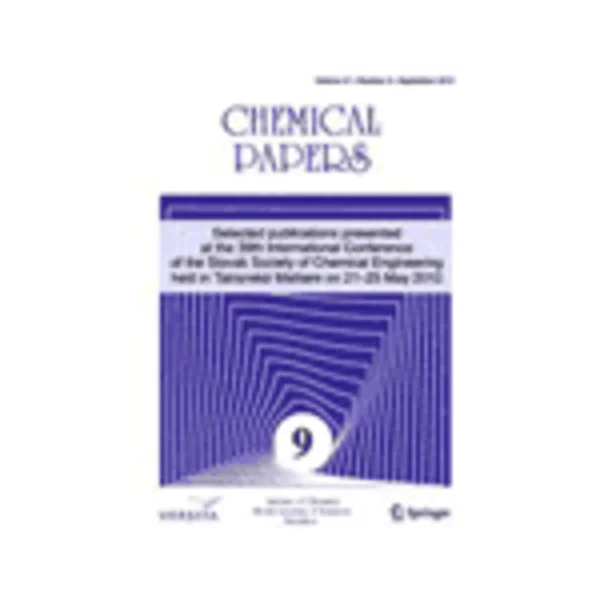-
development of oxopyrrolidine-based anti-cancer compounds: dna binding, in silico, cell line studies, drug-likeness and mechanism at supra-molecular level
جزئیات بیشتر مقاله- تاریخ ارائه: 1392/07/24
- تاریخ انتشار در تی پی بین: 1392/07/24
- تعداد بازدید: 1011
- تعداد پرسش و پاسخ ها: 0
- شماره تماس دبیرخانه رویداد: -
due to an increasing demand for effective anti-cancer drugs, an oxopyrrolidine-based ligand, sodium 1-(3-(2-aminoethylamino)propyl)-5-oxopyrrolidine-2-carboxylate, was synthesised by the sodium hydride-assisted coupling of pyroglutamic acid with 1,3-diiodopropane under a nitrogen atmosphere. the intermediate thus formed was allowed to react with ethylenediamine in acetonitrile. the ligand formed individual complexes with cu(ii) and ni(ii) metal ions, respectively. the complexes were relatively resistant to degradation in pbs at physiological ph. the dna-binding constants (k b) for the ligand, copper and nickel complexes were 2.09 × 104 m-1, 2.37 × 104 m-1 and 2.11 × 104 m-1, respectively, revealing the strong binding of these complexes with dna. haemolysis assays indicated that the ligand and its complexes were less toxic to rabbit rbcs than doxorubicin. lipinski’s parameters calculated for the reported compounds indicated their good oral bioavailability. all the compounds exhibited good activities towards mcf-7 (wild type) cancer cell lines. the results of in silico studies, dna-binding and anti-cancer activities indicated that the reported compounds might be interacting with dna as one of their possible mechanisms of action.
مقالات جدیدترین رویدادها
-
استفاده از تحلیل اهمیت-عملکرد در ارائه الگوی مدیریت خلاقیت سازمانی و ارائه راهکار جهت بهبود
-
بررسی تاثیر ارزش وجوه نقد مازاد بر ساختار سرمایه شرکت های پذیرفته شده در بورس اوراق بهادار تهران
-
بررسی تأثیر سطح افشای ریسک بر قرارداد بدهی شرکت های پذیرفته شده در بورس اوراق بهادار تهران
-
بررسی تأثیر رتبه بندی اعتباری مبتنی بر مدل امتیاز بازار نوظهور بر نقد شوندگی سهام با تأکید بر خصوصی سازی شرکت ها
-
تأثیر آمیخته بازاریابی پوشاک ایرانی بر تصویر ذهنی مشتری پوشاک ایرانی (هاکوپیان)
-
مقایسه روشهای تحلیل مستقیم و طول مؤثردر طراحی ستونهای قابهای خمشی فولادی
-
بررسی استفاده از روش بیولوژیکی در بهسازی خاکهای گچ دار
-
بررسی نقش خلاقیت در فرایند یاددهی – یادگیری
-
growth and characterization of in x ga1−x n multiple quantum wells without phase separation
-
free vibration analysis of fg nanoplates using quasi-3d hyperbolic refined plate theory and the isogeometric approach
مقالات جدیدترین ژورنال ها
-
مدیریت و بررسی افسردگی دانش آموزان دختر مقطع متوسطه دوم در دروان کرونا در شهرستان دزفول
-
مدیریت و بررسی خرد سیاسی در اندیشه ی فردوسی در ادب ایران
-
واکاوی و مدیریت توصیفی قلمدان(جاکلیدی)ضریح در موزه آستان قدس رضوی
-
بررسی تاثیر خلاقیت، دانش و انگیزه کارکنان بر پیشنهادات نوآورانه کارکنان ( مورد مطالعه: هتل های 3 و 4 ستاره استان کرمان)
-
بررسی تاثیر کیفیت سیستم های اطلاعاتی بر تصمیم گیری موفق در شرکتهای تولیدی استان اصفهان (مورد مطالعه: مدیران شرکتهای تولیدی استان اصفهان)
-
تاثیر سرمایه گذاران نهادی استراتژیک بر رابطه بین محافظه کاری حسابداری و ریسک سقوط قیمت سهام
-
اثربخشی زوج درمانی رفتاری بر نگرش به خیانت و سازگاری زناشویی در زوجین
-
شناسایی و اولویت بندی مسیرهای عمده کسب کسب و کارهای گردشگری مناطق روستایی شهرستان جیرفت با استفاده از عملگرهای فازی
-
تاثیر حضور زنان در کمیته حسابرسی بر کیفیت و حق الزحمه حسابرسی (شواهد تجربی: بورس اوراق بهادار تهران)
-
a review of the ankle joint movement in people with ankle instability




سوال خود را در مورد این مقاله مطرح نمایید :